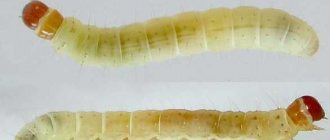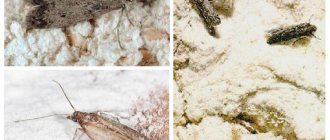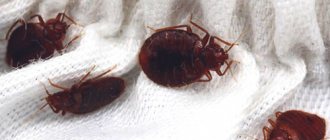In nature, there are several types of domestic moths: grain moths, furniture moths, clothes moths and fur moths. All these insects are capable of causing some damage to products and things. Many are familiar with the classic moth, which lives in closets and feeds on items made of fur and natural fabric. This is a small clay-yellow butterfly, from whose eggs many tiny moth larvae emerge. They are the ones who have a good appetite and pose a danger to things. Protecting fur coats, woolen products and food from moths is the task of every caring housewife. There are different methods of pest control, but the safest are folk remedies for moths. Our article will tell you how to get rid of moths using folk remedies.
Citrus peels
Orange or lemon peels are a traditional folk remedy against moths. Their strong smell is not to the liking of adults. Therefore, in every section of the cabinet where orange peels are laid out, butterflies will not dare to lay eggs. Tangerine peels have a similar effect.
Citrus peels
To obtain the desired effect, the peel of a tangerine or orange must be fresh; it is important to prevent it from drying out or developing mold. Since dry citrus peels do not have a strong aroma, they will not protect against pests. Therefore, they need to be changed regularly.
Important! You can use tangerine or orange peels only for preventive purposes, since they are not capable of getting rid of moth larvae that have already settled in a fur coat.
Cloves, thyme, rosemary
Cloves, thyme and rosemary
Having placed bags of thyme, rosemary and cloves around the apartment, you will not know what moths are for several months. The fact is that the insect cannot tolerate the spicy smell of these plants. Therefore, in order to get rid of pests forever, it is necessary to replace old aromatic sets with fresh ones from time to time.
Review
My wife is allergic to many insecticides, so we used traditional methods to fight moths. And after its destruction, bags of cloves were placed in cabinets. And the smell is pleasant, and moths do not bother me.
Oleg, Perm
Essential oils
Essential oils are an excellent and very effective folk remedy for repelling moths. In addition to the eucalyptus composition, lavender, fir, clove, lemon and rosemary oils are widely used. Insects do not like their fragrant aroma.
Using essential oils for moths is not difficult at all. It is enough to add a few drops of any oil to a container of water and wipe the shelves in the closets, floors, kitchen surfaces and furniture in the room with it. You can also spray the surface of upholstered furniture with this solution.
Important! To enhance the effect, cotton swabs soaked in oil will help, which should be placed in each room.
Plants
The three most famous folk variants are:
- Lavender. Both flowers and oil are used. The flowers are placed in porous bags, the oil is poured into an open container, and the whole thing is placed in a suspicious place. The strong (but pleasant to humans) aroma of lavender repels pests, and the aroma lasts quite a long time. Please note that you should not treat the clothes themselves with liquid, as this can lead to the formation of stains that are difficult to remove (provided that various fats are added to the preparation).
- Geranium. You can simply grow this plant in a pot. The fragrance of geranium is not digested by many insects. However, the range of such a tool is limited. For a large apartment you will need several bushes, and cabinets will need to be constantly opened to allow the aroma to penetrate them.
- Tobacco. Both fragrant tobacco (in the form of a plant) and regular smoking tobacco (in the form of dried leaves) are used. Fragrant tobacco is similar in method of application to geranium. Smoking tobacco is used in porous bags. Please note that it should not be used to protect clothing. It will, of course, repel moths, but your mink coat will get a persistent smell of tobacco, which you obviously don’t want. The spread of such an aroma throughout the apartment is also not a positive factor.
Bags of dried leaves and flowers can be placed in clothing pockets.
In addition to the listed plants, the following are used: wormwood, thyme, tansy, horse chestnut, mint, cloves and much more.
A classic folk remedy for repelling moths, familiar to many from childhood. Small pieces of soap are placed in different places in the apartment, where they do an excellent job of expelling pests and preventing their occurrence.
Soap also helps get rid of caterpillars, which is its advantage. The downside is that the lingering smell of soap on clothes is no better than tobacco, so care must be taken in suit closets. The aroma of soap does not improve food products either.
There is a popular opinion that laundry soap is the most effective for pest control, although practice shows that scented samples act in a similar way.
Naphthalene
Naphthalene is truly a folk remedy. Its effect in the fight against moths has been known since the time of our grandmothers. However, the latest research has proven that the drug contains carcinogenic substances that are unsafe for human health. Therefore, naphthalene was not used to kill food moths, since the products are capable of absorbing odors.
They began to use naphthalene against moths only in closets, laying it out on shelves, in bags with woolen items, in the pockets of coats and fur coats.
Laundry soap
An excellent folk remedy for moths in the closet is laundry soap. Both clothes and kitchen moths are afraid of its smell. The principle of use is quite simple: you need to place bars of scented soap in the closet between things or products. You can also treat all interior surfaces of furniture cabinets with soapy water.
Review
“To get rid of moths, I used laundry soap on the advice of my mother and reviews from a friend. I treated both the closet, which was favored by insects, and other places where clothes were stored for prevention. Afterwards I left small pieces of soap in the cabinets. Moths don’t bother me anymore!”
Inna, Ryazan
What are moths and their larvae afraid of: methods of extermination
The following methods are used to destroy adult moths and larvae:
- chemical;
- natural (biological).
The former are considered effective, but their influence is not always safe for adults, children and pets. There are two types of moths living in residential areas: food moths and clothes moths. Biological agents are used to combat both groups, and it is advisable not to use chemical insecticides near food.
Chemical repellents for moths
Insecticides for exterminating moths are divided into aerosols and fumigators. Today, many industrial preparations consist of natural ingredients and are safe for humans. There are chemicals with higher levels of toxicity for use in large domestic areas.
Other folk methods
Other folk remedies can also help in the fight against moths.
- Moths cannot stand the smell of cedar. By placing its branches and pieces of wood in your wardrobe, you will save your fur coat from moths. For the same purpose, you can use a folk remedy such as cedar oil.
- There will be no insects in the cabinets if you place tampons soaked in camphor in them.
- Black pepper is another folk remedy for controlling household pests. It’s enough to put bags of peas on the shelves, and no one will get into your things.
Black pepper, oil and cedar bark
Review
Irina, Moscow: “Traditional methods did not help in the fight against moths. Perhaps the reason is that there was a lot of it. We had to use chemicals."
Irina, Moscow
How plants fight moths
Having information about which plant repels moths with its smell, the question arises of how it does this. The fact is that these herbs, trees and bushes have organic substances represented by essential oils. They accumulate in fruits, roots, leaves, flowers, and seeds.
Different parts of the plant may have different concentrations of organic matter, so when collecting it is important to understand what is suitable for eliminating the parasite.
An insect can sense fragrant plants from moths even with a closed cabinet, since its sense of smell is 100 times better than that of a human.
However, ethers do not kill the parasite, but only drive it away, so this method is most suitable for preventing the penetration of adult individuals.
Wild growing repellents
Anti-moth plants can be found in fields, meadows, flower beds, and parks.
The most popular wild-growing repellents include:
- Sweet clover. Dried flowers are sprinkled on clothes. The aroma of moth grass is quite pleasant and persistent, which is facilitated by the abundance of coumarin in the composition.
- Oregano. Insecticidal properties help drive away fleas and bedbugs. To do this, sprigs of oregano are placed in the closet between things.
- Chamomile. The plant powder is used to prepare alcohol extract and alcohol extract. To preserve things, a little extract must be added to the water for rinsing clothes. Also popular are fabric pads that can be placed on shelves with clothes or in the kitchen next to cereals. An insect control drug called Flitsid is industrially produced from the flower powder.
- Ledum. It grows in peat bogs and forest clearings. For moths, you need flowers and twigs of the plant. Also, for prevention, you can fumigate with wild rosemary leaves.
House plants from moths
Even at home, plants that repel clothes moths can grow on the windowsill. This is possible thanks to the phytoncides they contain.
At home, it is not difficult to understand what moths are afraid of; fighters include:
- Lilies. They can be presented in the form of hippeastrum, eucharis, amaryllis, hymenocallis.
- Myrtle. The lemon plant contains citronellal and citral, which give the tree a corresponding citrus aroma. Soak fabric or cotton pads in oil and place them in the closet.
- Plectranthus. An unpretentious plant with a mint aroma.
- Geranium. There is no need to pick it, just put the flowering plant in a room where there is a parasite and the latter will leave it in a matter of days.
Benefits of folk remedies against moths
Many housewives give preference to folk remedies for protection against moths, resorting to radical methods of control only in extreme cases. And this is correct, since folk remedies do not contain harmful substances, therefore they are safe for human health. This is especially true for families with small children.
The advantages of folk remedies for moth control also include their availability and low cost, which is an important factor in modern life.
Do not forget that folk remedies for fighting moths are best used for preventive purposes. The most optimal option for using them, as well as special sections against moths, is before a winged pest appears in the house. If there is a large concentration of pests, complex treatment using insecticidal preparations for moths such as Antimol is necessary.
What moths are afraid of: repelling methods
One adult moth can lay 150-250 eggs, so it is advisable to prevent its appearance in the house. In addition to purchasing high-quality groceries, installing mosquito nets on windows, and other preventive methods, conditions in the house that are intolerable for the parasite are ensured. Specific smells help with this.
Products from the following categories repel insects:
- dry herbs and spices;
- essential oils;
- live indoor plants;
- fruit particles;
- some technical substances.
Repellents are harmless to humans, their smell does not cause negative sensations in other residents, unlike insect pests.
Spices and plants for moths
Some types of flowers and herbs (green or dried), as well as spices, have an odor that is incompatible with moths being in the house. Due to this property, they are used to repel insects by placing them in places of feeding and possible accumulation. These plant representatives include:
- wormwood (from moths, twigs and leaves are laid out in the closet, among food products, changed every 1-2 weeks);
- lavender (the flowers of the plant have a pleasant aroma for humans, but are intolerant to moths; they are effective for several months without the need to change);
- tansy (flower branches repel moths and other parasites);
- rosemary (we repel moths, but require frequent replacement);
- mint (suitable for protection against clothes moths, has a long-lasting effect);
- dill (in the form of herb or seeds);
- onions and garlic (placed in the kitchen and pantries to prevent food pests);
- red pepper (plant pods are used near cereals, bread products, flour);
- mixtures of chamomile, cloves, valerian, marigold.
Plants without a strong aroma or with a pleasant aroma for humans are placed together with clothes and fabrics. Specific substances are recommended for use in kitchen cabinets.
Twigs, flowers, moth grass are laid out in their natural form or packaged in separate fabric bags. There are special convenient sachets and sections made from natural ingredients on sale.
Essential oil for moths
The listed herbs and plants, some other representatives of the flora are effective against adult moths and their larvae in the form of essential oil. Additional oils used:
Adviсe
- At the end of the cold season, before storing a fur coat or hat, they must be cleaned and dried well.
- To store fur and wool products, it is better to use special cases in which dried herbs or oil-soaked tampons should be placed.
- You should regularly audit your wardrobe. Any insect will feel at ease where it is not disturbed. Therefore, regular inspection and cleaning of cabinets will help prevent the appearance of moths. Each fur or wool product must be carefully inspected for the presence of moth larvae.
- Fur items should be shaken regularly to prevent damage. After all, the larvae and eggs of insects adhere to them very weakly, and fall off at the slightest shaking. Therefore, during wearing, things are not exposed to insects. Those that sit on the shelf for a long time suffer more.
- Warm blankets, blankets, pillows and carpets must be periodically taken out into the fresh air to dry.
- If traces of pest activity are detected, all items in the closet should be heat treated against moths. In winter, they can be laid out in the cold or hung in direct sunlight in summer. Items that are subject to hot processing must be washed and ironed. When washing clothes, you can add a few drops of essential oil and vinegar to the water. Folk or chemical anti-moth remedies will not be superfluous.
- To prevent moths from infesting winter boots or boots, they must be dried before storing them. You can put any anti-moth remedy inside (a sprig of tansy or lavender, a tampon soaked in essential oil, or tobacco).
- To prevent kitchen moths from infesting the house, all bulk products brought home must be stored in glass jars or tightly closed containers.
- Regular cleaning and ventilation of the premises are the key to a clean, pest-free home.
Knowledge of folk remedies and the rules for their use will help prevent the appearance of moths in your apartment.











